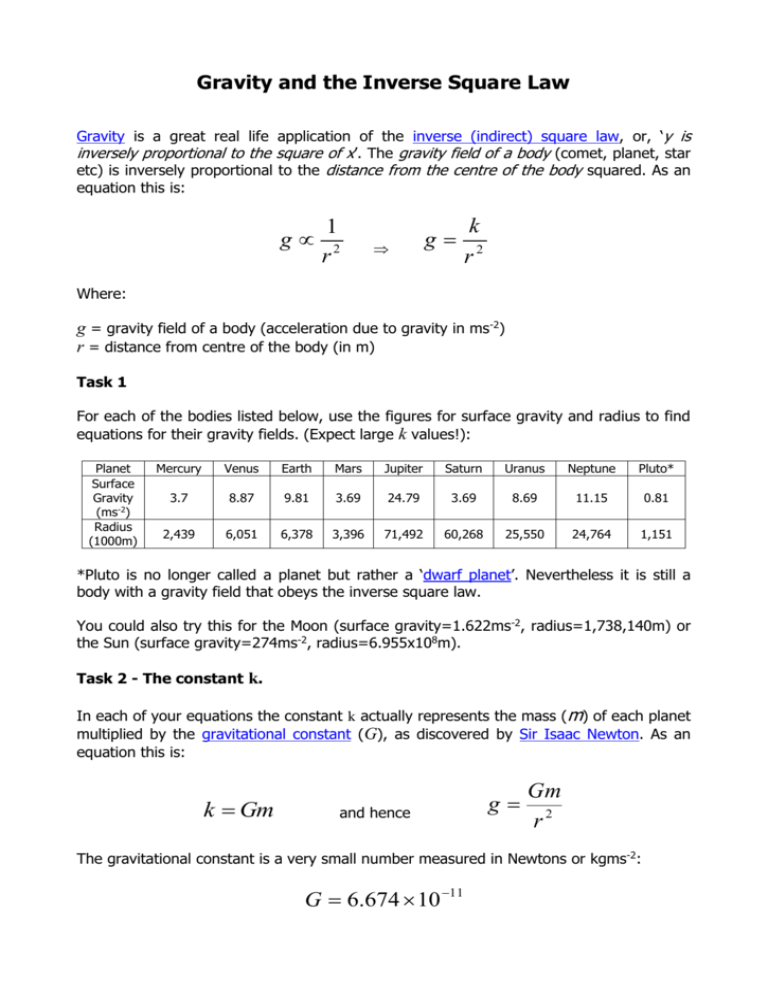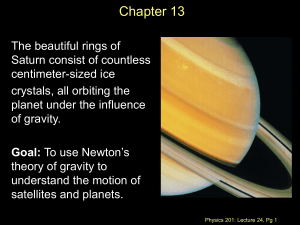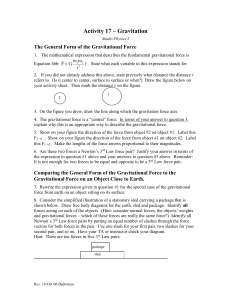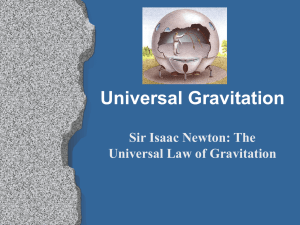Gravity and the Inverse Square law
advertisement

Gravity and the Inverse Square Law Gravity is a great real life application of the inverse (indirect) square law, or, ‘y is inversely proportional to the square of x’. The gravity field of a body (comet, planet, star etc) is inversely proportional to the distance from the centre of the body squared. As an equation this is: g 1 r2 g k r2 Where: g = gravity field of a body (acceleration due to gravity in ms-2) r = distance from centre of the body (in m) Task 1 For each of the bodies listed below, use the figures for surface gravity and radius to find equations for their gravity fields. (Expect large k values!): Planet Surface Gravity (ms-2) Radius (1000m) Mercury Venus Earth Mars Jupiter Saturn Uranus Neptune Pluto* 3.7 8.87 9.81 3.69 24.79 3.69 8.69 11.15 0.81 2,439 6,051 6,378 3,396 71,492 60,268 25,550 24,764 1,151 *Pluto is no longer called a planet but rather a ‘dwarf planet’. Nevertheless it is still a body with a gravity field that obeys the inverse square law. You could also try this for the Moon (surface gravity=1.622ms-2, radius=1,738,140m) or the Sun (surface gravity=274ms-2, radius=6.955x108m). Task 2 - The constant k. In each of your equations the constant k actually represents the mass (m) of each planet multiplied by the gravitational constant (G), as discovered by Sir Isaac Newton. As an equation this is: k Gm and hence g Gm r2 The gravitational constant is a very small number measured in Newtons or kgms-2: G 6.674 10 11 We can use this to find the mass of each planet. Divide each of your constant k values by G to find the mass (in kg’s) of each planet (and Moon and Sun). Task 3 - Further Questions 1. The Moon orbits the Earth at an average distance of 384 million metres (from its centre). What is the gravitational acceleration of the Moon towards the Earth as a result of the Earth’s gravitational field? 2. What is the gravitational acceleration of the Earth towards the Moon as a result of the Moons gravitational field? 3. The Earth orbits the Sun at an average distance of 150 billion metres (from its centre). What is the gravitational acceleration of the Earth towards the Sun as a result of the Sun’s gravitational field? 4. What is the gravitational acceleration of the Sun towards the Earth as a result of the Earths gravitational field? (What else should be considered if using this figure in any scientific argument?) 5. How far above the surface of the Earth is the strength of the gravitational field the same as on the surface of the Moon? 6. How far above the surface of Jupiter is the strength of its gravitational field the same as that on the surface of the Earth? Very Hard Questions: 7. At what distance from the Earth does the gravitational field of the Moon cancel out that of the Earth? 8. At what distance from the Earth does the gravitational field of the Sun cancel out that of the Earth? Your answers to questions 7 & 8 above are important to astronomers and space scientists as these points can be beneficial in satellite positioning. Points in space such as these, where one gravitational field counteracts another, are called Lagrangian Points. The SOHO satellite orbits one of these points between the Earth & Sun in order to gain an uninterrupted view of the Sun. The work that you have completed here is related to the Newton’s Universal Law of Gravitation: F But we’ll save this for another day! Gm1 m2 r2 Internet Links Gravity http://en.wikipedia.org/wiki/Gravity The inverse square law http://en.wikipedia.org/wiki/Inverse_square_law Gravitational Constant http://en.wikipedia.org/wiki/Gravitational_constant Sir Isaac Newton http://en.wikipedia.org/wiki/Isaac_Newton Lagrangian Points http://map.gsfc.nasa.gov/mission/observatory_l2.html SOHO Satellite http://sohowww.nascom.nasa.gov/home.html Newton’s Universal Law of Gravitation http://en.wikipedia.org/wiki/Newton%27s_law_of_universal_gravitation Answers – k Values and Masses of Planets Planet Mercury Venus Earth Mars Jupiter Saturn Uranus Neptune Pluto k 2.2x1013 3.3x1014 4.0x1014 4.3x1013 1.3x1017 1.3x1016 5.7x1015 6.8x1015 1.1x1012 Mass (kg) 3.3x1023 4.9x1024 6.0x1024 6.4x1023 1.9x1027 2.0x1026 8.5x1025 1.0x1026 1.6x1022 Moon: k = 4.9x1012, mass = 7.34x1022 kg Sun: k = 1.3x1020, mass = 2.0x1030 kg Further Answers 4 1014 2.7 10 3 ms 2 1. g 8 2 (3.84 10 ) 1.33 10 20 5.91 10 3 ms 2 3. g 11 2 (1.5 10 ) 4.9 1012 3.32 10 5 ms 2 2. g 8 2 (3.84 10 ) 4 1014 1.78 10 8 ms 2 4. g 11 2 (1.5 10 ) 4 1014 2.466 1014 1.57 10 7 m , 5. r 1.622 From surface 1.57 10 7 6.3781 10 6 9.32 10 6 m 9,320km 1.3 1017 1.325 1016 1.15 10 8 m 9.81 From surface 1.15 108 7.1492 10 7 4.36 10 7 m 43,600km 6. r 7. 3.46 108 346,000km (with 3.82 10 7 38,200km remaining) 8. 2.59 108 259,000km (with 1.497 1011 149,700,000km remaining). (The Moon remains in Earth orbit due to its momentum.) Hints for questions 7 and 8 are on the next page. Hints for Questions 7 & 8 Method 1 Consider a point in space somewhere between the two bodies where the gravitational fields of each body are equal in strength and thus cancel each other out. At this point the formulae for the gravitational fields of each body are equal. For the Earth / Moon system the formulae may look like this: GmE rE 2 GmM rM mE 2 rE 2 mM rM 2 rE mE rM mM By rearranging to give masses on one side of the equation, and distances on the other, we find an expression for the ratio of the masses of the bodies. Since we know these masses we are thus able to find a value for this ratio. Finally, the square root of this ratio, or value, is then equal to the ratio of the distances between the bodies. Since we know the total distance between the bodies we are thus able to find a value for the distance of our point in space from either body. Method 2 x = distance from Earth, y = total distance to Moon. Then: kE kM x 2 ( y x) 2 k E ( y 2 2 xy x 2 ) k M x 2 k E y 2 2k E xy (k E k M ) x 2 0 a (k E k M ) b 2k E y c kE y 2 Quadratic formula: x 2k E y ( 2k E y ) 2 4 ( k E k M ) k E y 2 2 (k E k M ) x 3.46 108 346,000km









